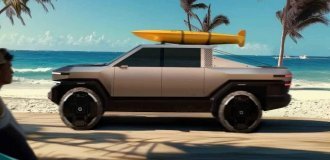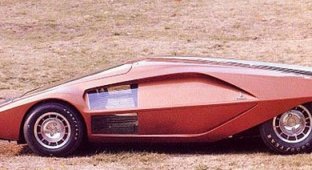Opening headlights first appeared on the American Cord 810 model back in 1936. This car was equipped with special handles on the instrument panel, which were used to manually lift the front optics built into the front fenders.

1936 Cord 810 convertible
Electric/hydraulic/pneumatic drive and “blind” optics became widespread already in the 70-80s and early 90s of the last century. In addition to purely aesthetic and design considerations, some manufacturers have used this solution to circumvent certification rules regarding headlight adjustment. For example, it was because of this that Toyota exported a version of the Corolla AE86 with pop-up headlights to the American market.

Toyota AE86 with blind optics

Motorcycle Suzuki Katana

Lamborghini Countach LP400
In most cases, hidden optics were installed on sports coupes and convertibles, but some companies experimented with them even on sedans and hatchbacks, remember - Aston Martin Lagonda, Mazda 323F, Mazda 929, Honda Accord, Volvo 480.

Honda Accord sedan

Aston Martin Lagonda with blind headlights
However, by the mid-90s, the popularity of “blind” optics began to rapidly decline: first, such headlights disappeared on mass models, and a little later even manufacturers of exotic supercars abandoned them. A significant influence on events was new safety regulations that restricted various protrusions from the car body to protect pedestrians, making the design of hidden headlights more complex and expensive. Well, the final point was the rapid development of LED technologies, as more efficient and compact: in 2004, pop-up headlights finally “retired.”

Pre-styling Mitsubishi 3000GT with retractable headlights

Mazda 323F
And what a “wow effect” the “blind” optics caused on the first foreign cars that were imported into the CIS in the early 90s. Even a shabby Ford Probe, Mitsubishi Eclipse or Toyota Celica was perceived by ordinary people almost like a Ferrari only due to the unusual “eye sockets”: many even drove with open headlights during the day to arouse envy and delight among others. There is no need to talk about the fact that girls flocked to such cars and their owners like bees to honey: in those years it was a very effective tool for a street “pickup.”

Ford Probe

Legendary Toyota Celica
Well, today I invite you to familiarize yourself with the 10 latest cars that were equipped with pop-up headlights. So to speak - let's remember a design element that is unlikely to ever return to the assembly line. The list is arranged in chronological order - in ascending order of the final year of production:

Chevrolet Corvette 2004
The most famous and popular American sports car. The C5 generation received a new platform with suspension on transverse carbon springs, a monocoque on a powerful spatial frame, and a transaxle layout with a gearbox located at the rear axle. The standard version was equipped with an LS1 engine (V8, volume 5.7 liters, power 345 hp), and the charged Z06 version was equipped with an LS6 unit with 385 horsepower (later 405 hp). A total of 247,851 Corvette C5 coupes and convertibles were built.

Lotus Esprit 2004
This British supercar is considered a real long-liver: having survived several thorough modernizations at once, the model lasted on the production line for almost 30 years - from 1976 to 2004. The final chord was the V8 version with a 3.5-liter 8-cylinder Type 918 engine (our own design) with a power of 350 hp .With. Thanks to its low weight (1300 kg), the car accelerated from 0 to 100 km/h in just 4.5 seconds.

De Tomaso Guara 2004
Only 50 copies of Guara came out of the gates of the small but quite famous Italian company De Tomaso. Since 1993, this model was equipped with a 4.0-liter BMW M60 V8 engine, and in 1998 its place was taken by a more affordable and powerful V8 from Ford (320 hp). In the last year of production, the coupe was offered for 118 thousand euros, and for the open Barchetta they asked for 104 thousand euros.

Cizeta-Moroder V16T
A spectacular supercar with a very difficult fate, which deserves a separate blog entry. Magnificent design work by Marcello Gandini and an unusual power plant configuration - V16. Between 1991 and 1995, only 19 copies were produced (including 1 prototype). In 1999, 2 more coupes were built, and 4 years later, an open model was produced by special order, which was named Cizeta Fenice Spyder TTJ. Until recently, the car was still offered to potential customers at a price of 650 thousand dollars, however, there were no more daredevils.

Ferrari 456 2003
An elegant and luxurious coupe with a 2+2 seating arrangement, a classic layout and a powerful 12-cylinder engine under the hood. Production of the model began in 1992, and 6 years later the Italians presented a modified version of the 456M with a slightly modified design and improved interior design. The power of the 5.5-liter engine remained at the same level - 442 hp.

Mazda RX-7 2002
The legendary third generation Ryksa (FD) was introduced in 1991. The main feature of the model was the 13B-REW rotary piston engine with twin turbocharging. With a displacement of only 1.3 liters, this unit produced as much as 265 hp, and on some versions for the Japanese market the power reached 280 hp. And then - these were legal restrictions: the engine was easy to tune, as a result of which its output increased by more than 2 times. The model has gone through as many as 5 updates: in 1993, 1995, 1996, 1998 and 1999. In 2002, Mazda introduced its final limited edition model, the RX-7 Spirit R.

Pontiac Firebird 2002
The fourth and final generation of the Firebird appeared in 1993 and until the very end was produced exclusively with pop-up headlights. This car differed from its brother - the Chevrolet Camaro. At the end of its production, the Firebird was equipped with a 3.8-liter V6 or the top-of-the-line 5.7-liter V8 LS1 (from the Chevrolet Corvette C5) producing 310 (Trans Am) or 325 (WS6) hp.

Acura/Honda NSX 2001
Japanese Ferrari, a car that made a lot of noise when it appeared in 1990. Even the legendary Formula 1 driver Ayrton Senna had a hand in its creation. The mid-engined sports car was originally equipped with a 3.0-liter V6 engine producing 274 hp, which allowed it to reach a top speed of 270 km/h and compete with younger models from Ferrari and Porsche. In 2001, the Japanese carried out a restyling and replaced the “blind” optics with regular headlights. The model boasts phenomenal reliability and survivability compared to other sports cars: is this not uncommon? when the owners drove the NSX for 200-300 thousand kilometers without serious breakdowns or repairs.

Venturi Atlantique 2000
Stylish 2-seater sports coupe from the little-known French company Venturi Automobiles. From 1999 to 2000, an extremely small edition of the Atlantique 300 Biturbo version with a 3.0-liter V6 (PSA) with twin turbocharging was produced. Machine with a power of 310 hp. developed a maximum speed of 275 km/h, and acceleration from 0 to 100 km/h took about 5 seconds. In the same year 2000, the company declared bankruptcy.

BMW 8-Series E31 1999
The legendary luxury coupe of the gran turismo class still makes heads turn when it appears on the roads. A very noble and at the same time aggressive appearance made the G8 a cult car during its lifetime. Over 10 years of production, 31,062 copies were built with V12 (model 850) and V8 (840) engines. The car is gradually becoming a classic, and prices for well-maintained cars are growing rapidly every year.























